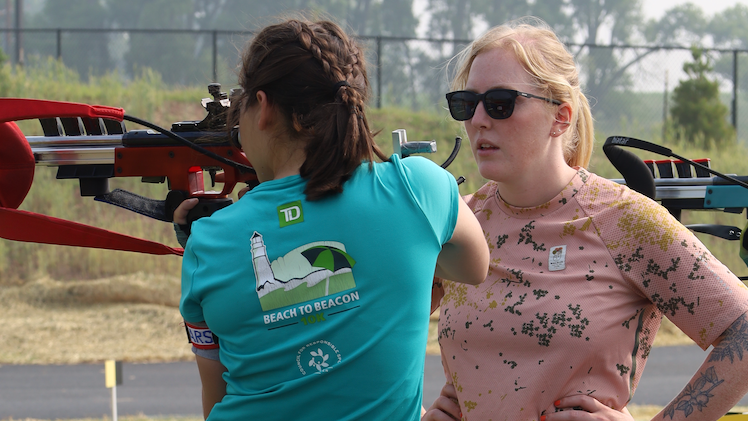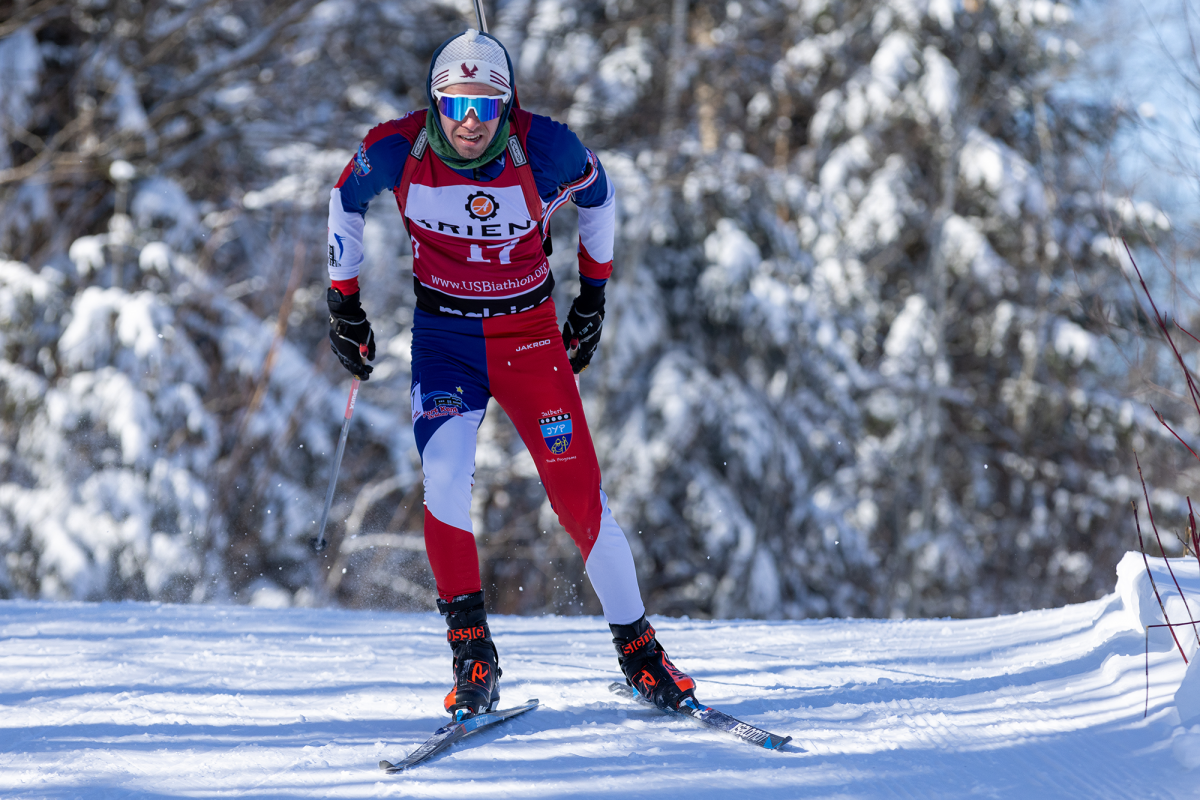
Despite tying his career-best World Cup result last year, winning three IBU Cup races and hitting the podium in another, and securing a spot on Biathlon Canada’s “A” team, until recently Nathan Smith wasn’t feeling too confident about the upcoming season of racing.
“I got a cold at the end of August and I guess I underestimated how much of a toll it took on me,” he told FasterSkier in an interview on Thursday. “So I did the NorAm races here in September and then went on a camp to Austria. I was pretty tired from that and October was pretty rough – I wasn’t feeling like my usual self. But within the last two or three weeks, I feel like I’m starting to get back into better shape.”
That fitness was on display last week, when the Canadians had two time trials in Canmore on their two-kilometer on-snow loop, Frozen Thunder. In the sprint, Smith shot one penalty in each stage and finished a second off the podium.
“It was a lot better for me,” Smith said. “I was pretty happy with my skiing, and shooting was good, especially in the pursuit considering that it was very windy at the range. So I’m happy with it… now I’ve had a couple of good time trials, so I’m feeling good about going into the season. I was a little bit worried earlier.”
While Smith, as an “A” team member, is pre-qualified for the first World Cup races in Östersund, Sweden, the pressure is far from off. He has never spent a full season competing on the World Cup circuit: thanks to Biathlon Canada’s philosophy that athletes should routinely excel at IBU Cup races before making the jump to the World Cup, there’s typically a lot of movement in and out of the last starting spots on Canada’s World Cup team over the course of the season.

There’s added pressure this year because the organization will more or less select the team for World Championships, to be held in mid-February, before Christmas.
“Due to a very unusual IBU Cup schedule, we do not anticipate having any IBU Cup athletes in Europe during January, just our World Cup team,” Biathlon Canada High Performance Director Chris Lindsay wrote in an e-mail. “This means that if you are on the World Championships team you will have been at the World Championships prep camp [in early February], and to be at the prep camp you were probably at World Cups five and six [in January], and to be selected for [them] you will have had to do well in December.”
Although Lindsay stressed that total season performance would be considered in selecting the Championships team, and that World Cup athletes who didn’t perform well in the January World Cups wouldn’t be kept in Europe if other athletes had excelled in IBU Cup races, the strange schedule definitely puts the pressure on to perform well early in the season and hold onto a World Cup starting spot.
“December is really important for us,” said Smith, who has raced at three prior senior World Championships and finished 43rd in the pursuit at the 2012 edition. “You have to show what you can do.”
He’s also already thinking ahead to the Olympics, since the qualifying window is now open and senior athletes can only qualify through World Cup and World Championship events. Doing so is another reason to stay on the World Cup rather than bouncing down to the IBU Cup, where he won three races last year.
“I’d like to make some Olympic criteria,” he said. “As a senior, you have to be going for top-30’s on the World Cup, so I would like to get a few of those, and then that will help a lot. Last year I didn’t have any top-30’s, but I think that some of my best IBU Cup races would have been at that level, so I hope that I can pull off races like that on the World Cup when I need to.”
That’s a lot to think about, but luckily the team has been having fun as well. Last Tuesday, part of the national team headed to Calgary to try out speedskating.
“It was pretty fun, but then yesterday we had to do our time trial and then again today, and pretty much everyone was complaining about their backs hurting because you have to bend over so much,” Smith said. “Yesterday my back was destroyed, but now it’s better. So it was fun, but next time I won’t do that this time of year.”
It was a good exercise – “I can’t really think of anything that would be closer to cross-country skiing, the way that you’re supposed to set your foot and the balance,” Smith said – and typical of the Canadian team’s current tendency towards involvement with other sports. Head coach Matthias Ahrens, Smith said, had invited some of the speedskaters up to try an agility course and other biathlon training in Canmore earlier this year. And then there’s the increased collaboration with the national cross country team.
“We did two or three intensity workouts with their team this year,” Smith said of the skiers. “Obviously that’s not a lot, maybe not enough, but it’s a start and it’s more than we have done before, so that was good. I hope it continues.”
The issue of joint training is similar to that faced by the American ski and biathlon teams: how do you coordinate schedules? The skiers, Smith said, are often gone on camps, much more so than the biathletes. So even they are both at home base (more or less) in Canmore, it’s tough to line up workouts.
“We do see them,” Smith said. “I’ve been seeing Ivan [Babikov] out there pretty much every day.”
In addition to training, the two teams have gone in on a few other things together. One is the new rollerski treadmill in Canmore, which both groups used for testing. They also announced their national teams at the same time in a joint media event.
“That’s good especially for raising our profile,” Smith said. “Biathlon Canada is maybe riding their coattails a little bit. I think it’s partly because Chris Lindsay, our High Performance Director, is based out of Canmore now [he had been in Ottawa], so he probably gets to chat more with the cross country guys. That’s certainly a good thing.”
Having a few more training partners was especially beneficial for the men’s team this year because Brendan Green, one of the most successful of the biathletes, has been out since February with a bad back and will likely miss the whole competition season.
“We definitely miss training with him,” Smith said. “He’s always pushing us.”
While Green’s absence is a blow to the team, it might help Smith in his quest to stay on the World Cup, however.
“A lot of the time I’m kind of the fourth guy, and without Brendan last year we lost quite a bit of points at the end of the season so we actually only have three World Cup spots this year,” Smith explained. “It is unfortunate. So if Brendan was racing I would probably hardly do any World Cups. So I guess that’s one positive thing for me, but it’s not really that great.”
Luckily, Smith said, Green didn’t fashion himself as the team captain, so leaving him at home in Canada doesn’t create as much of a hole as it could have.
“Brendan is a pretty quiet guy,” he said. “I know he had the best results out of all of us, but he never really – he doesn’t like to be the leader. I don’t think our team really has a leader. Obviously Scott Perras and I really look up to the results that Brendan and JP [Le Guellec] have gotten, but it’s not really a leadership thing.”
For another week or so, Smith is with the team in Canmore, training away until they depart for Sweden. That means more loops on Frozen Thunder.
“Last week was pretty warm here,” he lamented. “We lost all of our natural snow, and Frozen Thunder was getting pretty thin and dirty. There were lots of rocks. But then a cold front came in and it started snowing, so it’s getting better. Just a little bit on top really helped it out.”
Is he getting bored of skiing around such a small loop?
“I don’t know, it’s okay, especially with shooting,” Smith said. “I think if you’re a cross country skier, it would be a lot worse.”



